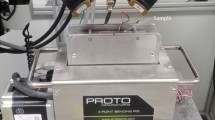Abstract
A new specimen geometry, the shear-compression specimen (SCS), has been developed for large strain testing of materials. The specimen consists of a cylinder in which two diametrically opposed slots are machined at 45° with respect to the longitudinal axis, thus forming the test gage section. The specimen was analyzed numerically for two representative material models, and various gage geometries. This study shows that the stress (strain) state in the gage, is three-dimensional rather than simple shear as would be commonly assumed. Yet, the dominant deformation mode in the gage section is shear, and the stresses and strains are rather uniform. Simple relations were developed and assessed to relate the equivalent true stress and equivalent true plastic strain to the applied loads and displacements. The specimen was further validated through experiments carried out on OFHC copper, by comparing results obtained with the SCS to those obtained with compression cylinders. The SCS allows to investigate a large range of strain rates, from the quasi-static regime, through intermediate strain rates (1–100 s−1), up to very high strain rates (2×104s−1 in the present case).
Similar content being viewed by others
References
Campbell, J.D. andFerguson, W.G., “The temperature and strain rate dependence of the shear strength of mild steel,”Phil. Mag.,21,63–75 (1970).
Duffy, J., Campbell, J.D., andHawley, R.H., “On the use of a torsional split Hopkinson bar to study rate effects in 1100 O aluminum,”J. Appl. Mech.,38,83–91 (1971).
Hundy, B.B. andGreen, A.P., “A determination of plastic stress-strain relations,”J. Mech. Phys. Solids,8,16–21 (1954).
Meyer, L.W. andManwaring, S., in Metallurgical Applications of Shock Wave and High-Strain Rate Phenomena, Murr, L.E. et al Eds, Marcel Dekker Inc., NY (1986).
Klepaczko, J.R., “An experimental technique for shear testing at high and very high strain rates,”Int. J. Impact Eng.,46,25–39 (1994).
Clifton, R.J. andKlopp, R.W., in Metals Handbook: Mechanical Testing,8,ASTM,Metals Park, Ohio (1986).
Hibbitt, Karlsson and Sorensen, Inc. ABAQUS/Standard User's Manual, Version 5.6, (1996).
Kolsky, H., “An investigation of the mechanical properties of materials at very high rates of loading,”Proc. Phys. Soc. London,62-B,676–700 (1949).
Nemat-Nasser, S., Ni, L., andOkinaka, T., “A constitutive model for fcc crystals with application to polycrystalline OFHC copper,”Mech. of Materials,30,325–341 (1998).
Author information
Authors and Affiliations
Rights and permissions
About this article
Cite this article
Rittel, D., Lee, S. & Ravichandran, G. A shear-compression specimen for large strain testing. Experimental Mechanics 42, 58–64 (2002). https://doi.org/10.1007/BF02411052
Received:
Revised:
Issue Date:
DOI: https://doi.org/10.1007/BF02411052




